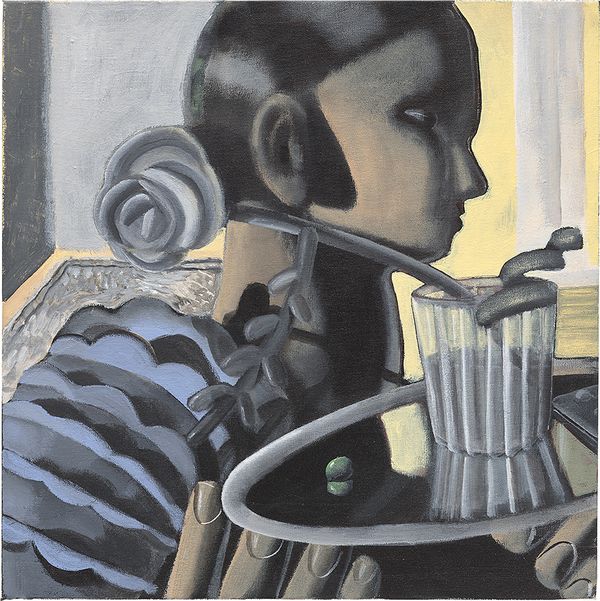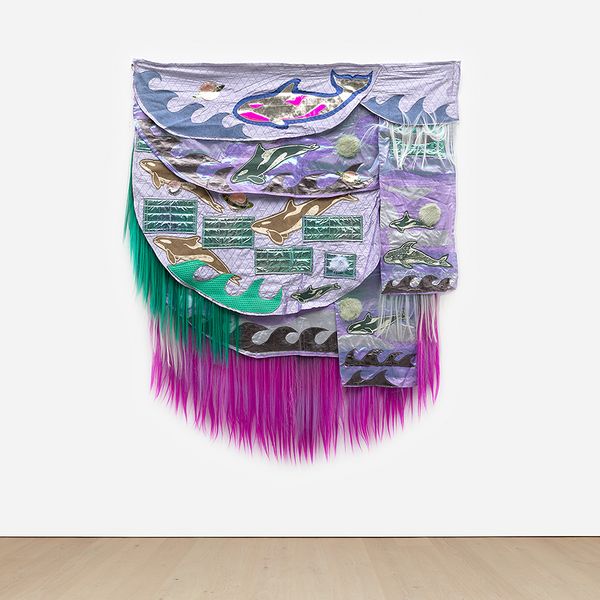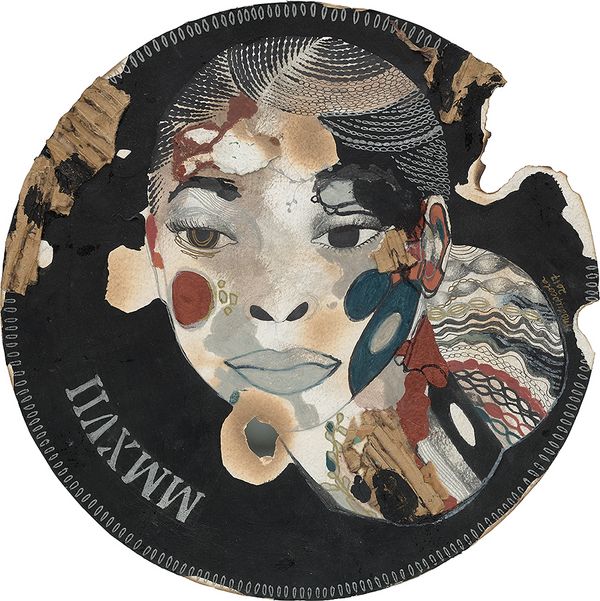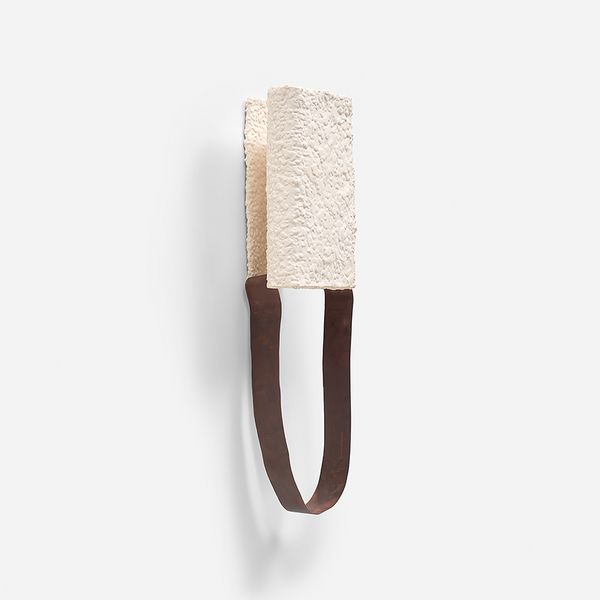Zadie Xa, Orca, 2019. New Now London.
Seven female-identifying artists are highlighted below as features of the Phillips New Now Sale in December. Provided from the collection of Serge Tiroche, the works demonstrate a breadth of style and medium that coalesce here in aiding the promotion of contemporary African art. Having founded Africa First in 2017, Tiroche has continued to champion contemporary art from the continent. As each artwork is unique in its ability to enthrall the viewer and speak to the artists’ varied backgrounds, they share a common impetus.
Aks Misyuta
Aks Misyuta, Sunrise, 2019. New Now London.
The entrancing works of Aks Misyuta’s defy easy categorization. Based in Istanbul, she employs a geometrically stylized approach that at once calls to mind abstraction, Cubism, figuration, and Surrealism. Upon close inspection, there’s a dissonance of visual meaning in her imagery that is as dystopian as it is inviting. In Sunrise, we see these ideas employed to exceptional effect, rendered in the artist’s characteristically muted, yet softly glowing color palette. Any common object — a straw, a flower, a glass — seems to merge and rebel against our expectations of its function. As viewers we can’t be sure, for example, if we’re seeing a rose or a hairclip, a straw or a stem, a portrait of a living figure or a painting of sculpture.
In this way, the work invites us in and then challenges us as it blurs any lines between still life and portraiture. Born in 1984 and self-taught as a painter, Misyuta has been the subject of numerous exhibitions, including at Galerie Sébastien Bertrand in Geneva and at Union Pacific in London.
Zadie Xa
Zadie Xa, Orca, 2019. New Now London.
Zadie Xa’s practice combines many cultural reference points which she draws from her Korean and native Canadian heritage. These include streetwear, music videos, quilting techniques, and traditional clothing. Much of Xa’s work is preoccupied with using water and marine ecologies to explore the fantastical while also considering themes of homeland. In Orca, many of these influences converge to create a work that reels with cultural relevance. The bright and playful colours call to mind the aesthetic of early 2000’s pop cultural fashions from the artist’s youth, whilst the colourful fringe add layers of movement. The orca motif refers to Xa’s interest in the close-knit family bond exhibited by orca pod, acknowledging the matrilineal social structures of cetaceans.
Xa’s work has been shown in solo and group exhibitions at numerous galleries in Canada, the United States, and Europe, including Serpentine Gallery in London, UK (2016); Palais de Tokyo, in Paris, France (2018); Polygon Gallery in North Vancouver, British Columbia (2021); and Remai Modern in Saskatchewan, Canada (2020–2021), among others.
“If we have some knowledge bestowed upon us, it’s selfish to not share that with each other.”
—Zadie Xa
Ruby Onyinyechi Amanze
Ruby Onyinyechi Amanze, Dangerous [Alien] Women, 2015. New Now London.
Existing in a multi-geographic space, Dangerous [Alien] Women, is a prime example of Onyinyechi Amanze’s continued exploration of cultural hybridity. Her work confidently tackles the marginalization that women of color experience as products of cultural displacement. Aligned with Heifetz’s work, it emboldens the lived experience of women throughout our histories and today. Employing found images, Onyinyechi Amanze evolves her preferred medium of drawing and utilises the loaded symbolism condensed into single motifs. Her work conveys cultural displacement, anxiety, and identity, inspired by her “pieced-together memories” of Nigeria.
Ruby Onyinyechi Amanze has continued to exhibit in solo shows in the USA, South Africa and the UK. Some of which include there are even moonbeams we can unfold (2018) at Goodman Gallery, Cape Town, South Africa; Astroturf rooftop picnics (2015) at Morgan Lehman Gallery, New York, NY and a story. in parts. (2015) at Tiwani Contemporary, London, UK.
Chitra Ganesh
Chitra Ganesh, The Camera, 2010. New Now London.
In a career now spanning two decades, New York-based Indian artist Chitra Ganesh has called on a rich variety of mediums in her artistic expression, from painting and drawing to video-based art and installations. It’s no surprise, then, that the paper surface of her 2010 work The Camera blends acrylic, watercolor, ink, pigment, garland, glitter, pearls, graphite, glue, and even glass beads. Influences on her visual language range from the historic Hindu and Buddhist imagery of South Asian cultures to contemporary video games and comics.
This broad range of influences and mediums combine in works that seamlessly blend the ancient and contemporary. Her work presents women in positions of power and in command of their sexuality, stemming from the artist’s observation of the exclusion of these themes in the traditional canons of literature and visual arts. Ganesh’s educational background is equally wide in scope — she studied literature at Brown University and painting at Columbia University. Her work has been widely exhibited in the United States and internationally, including in solo shows at the Brooklyn Museum in New York, the Andy Warhol Museum in Pittsburgh, and the Gothenburg Kunsthalle.
Modupeola Fadugba
Modupeola Fadugba, At Face Value V, 2017. New Now London.
A round surface, scorched paper edges, and the likeness of an empowered contemporary Black women. What’s before us could only be one of the many charged works from Nigerian artist Modupeola Fadugba’s series Heads or Tails. The series places black women on Nigerian and global currency, making a critical statement about their perceived cultural value. Her signature burned edges lend an ancient quality to the works that remind us of the historical absence of Black women in one of the most pervasive quotidian visual genres: currency portraiture. It’s as if the serene yet provocative subjects in the series peer back at us, asking plainly, “What am I worth to you?”
Such cultural and socioeconomic questions are forefront for the artist, who holds degrees in Chemical Engineering, Economics, and Education from the University of Delaware and Harvard University. The self-taught artist is rapidly on the rise and has already held numerous international solo exhibitions throughout Africa and Europe. Her work is also included in global institutional collections including the Minneapolis Institute of Art in Minnesota, the Smithsonian Institute of African Art in Washington, D.C., and Sindika Dokolo Foundation in Angola.
Roey Victoria Heifetz
Roey Victoria Heifetz, Trio, 2011. New Now London.
Roey Victoria Heifetz’s large-scale drawings typically deal with the drastic discrepancies between the social expectations and physical reality of ageing through womanhood. Identifying as a trans-woman, her poised inquisition of modern femininity is rendered in monumental and unglamorous terms. Her works explore the psychological and emotional journey that many women are expected to endure throughout their lives. Heifetz was born near Tel-Aviv but now resides in Berlin and often takes the women she meets or sees on the street as a starting point for her practice.
In 2019 Roey Victoria Heifetz has exhibited at Third Body at Tel Aviv Artist House as well as Shabees Goy, a group exhibition at Jüdische-Kulturtage, Düsseldorf. In addition, Heifetz was the featured artist for the Israeli pavilion at the Venice Biennale with her work Block of Clay. She was the 2018 Winner of Ann and Ari Rosenblatt Prize for Visual Artist as well as the 2019 grant recipient for the Lottery Foundation, Mifal Hapis in Israel.
Gizela Mickiewicz
Gizela Mickiewicz, I know about it but I don’t know it, 2017. New Now London.
The work of Polish sculptor Gizela Mickiewicz centers the physical while exploring conceptual ideas of reality and the sense of self. She treats her materials as a defined language, carefully choosing them to manage connotations and to explore the boundaries between outward reality and inward nuance. Curious and probing titles abound in her oeuvre, and this 2017 work I know about it but I don’t know it is no different. “I like to feel the resistance of reality, the difficulties of all kinds. Negotiations with reality have repeatedly led me to new, good solutions,” the artist has shared.
Her sculptures explore a captivating ambiguity — that space wherein we relate to an idea or object, yet also project ourselves upon it. The metallic materials that make up this work come together to present an object that defies its material reality through its soft, almost paper-like appearance. Seemingly fragile, it appears as if it could crumble before our eyes. This contradiction invites us to question reality, consider our perception, and explore the psyche of ourselves and the artist. Based in Warsaw, Gizela Mickiewicz graduated from the University of the Arts Poznań in 2012. She has completed residencies at Gasworks in London and Triangle in New York and has been the subject of several solo exhibitions, including at L21 in Mallorca, Galeria Stereo in Warsaw, and Lucas Hirsch in Düsseldorf.
Discover More from New Now, London >







